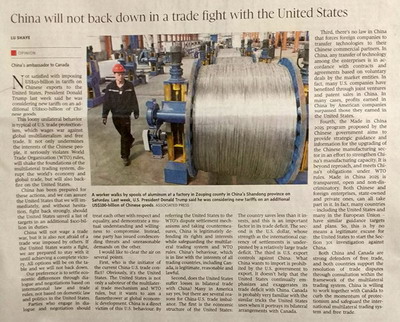駐加拿大大使盧沙野發表署名文章《美國挑起對華貿易摩擦,中國不會退縮》
Lu Shaye: China will not back down in a trade fight with the US

2018年4月9日,加拿大《環球郵報》發表駐加拿大大使盧沙野署名文章“美國挑起對華貿易摩擦,中國不會退縮”。全文如下: | On April 9, the Globe and Mail published an article of Ambassador Lu Shaye titled "China will not back down in a trade fight with the United States". The full text is as follows: | |
美國挑起對華貿易摩擦,中國不會退縮 | China will not back down in a trade fight with the United States | |
繼宣布對價值500億美元中國出口商品加征關稅的清單后,美國總統特朗普上周又放言要考慮再對中國1000億美元出口商品加征關稅。 | Not satisfied with imposing US$50-billion in tariffs on Chinese exports to the United States, President Donald Trump last week said he was considering new tariffs on an additional US$100-billion of Chinese goods. | |
美方這一瘋狂的舉動是典型的單邊主義和貿易保護主義,是對全球多邊主義和自由貿易的宣戰,不僅損害中國人民的利益,嚴重違反世貿組織規則,動搖多邊貿易體制根基,沖擊世界經濟和全球貿易的正常發展,而且最終將損害美國自己的利益。 | This loony unilateral behavior is typical of U.S. trade protectionism, which wages war against global multilateralism and free trade. It not only undermines the interests of the Chinese people, it seriously violates World Trade Organization (WTO) rules, will shake the foundations of the multilateral trading system, disrupt the world's economy and global trade, but will also backfire on the United States. | |
中方不會坐以待斃,我們已做好充分準備。請美國放心,一旦美方公布新增1000億美元商品征稅清單,我們將毫不猶豫、立即進行強力反擊。 | China has been prepared for these actions, and we can assure the United States that we will immediately, and without hesitation, fight back strongly, should the United States unveil a list of targets in an additional $100-billion in duties. | |
中方不想打貿易戰,但不怕打貿易戰。美方要打多久,我們就打多久,一直打到完全勝利。我們不排除任何選項,而且一定會說到做到。中方一貫主張也愿意通過對話協商解決糾紛,但對話協商應遵循國際法和國際貿易規則,而不是美國的國內法;要做到相互尊重、平等相待,而不是居高臨下、單方脅迫;要體現互諒互讓、有取有予的原則,而不是漫天要價、胡攪蠻纏。 | China will not wage a trade war, but it is also not afraid of a trade war imposed by others. If the United States wants a fight, we are prepared to stay with it until achieving a complete victory. All options will be on the table and we will not back down. Our preference is to settle economic differences through dialogue and negotiations based on international law and trade rules, not based on domestic law and politics in the United States. Parties who engage in dialogue and negotiation should treat each other with respect and equality, and demonstrate a mutual understanding and willingness to compromise. Instead, one party has issued condescending threats and unreasonable demands on the other. | |
在此,我想澄清幾個觀點。首先,誰是中美貿易沖突的始作俑者?很明顯,是美國。美不僅是多邊貿易體制和世貿規則的破壞者,也是給全球經濟發展增添不穩定因素的煽風點火者。中國是直接受害者。中國在對美方采取反制措施的同時,將美訴諸WTO爭端解決機制。中國的反應和舉措恰恰是為了維護本國合法權益,捍衛多邊貿易體制和世貿組織規則,合情合理合法,符合包括加拿大在內的各國和各國人民利益。 | I would like to clear the air on several points. First, who is the initiator of the current China-U.S. trade conflict? Obviously, it's the United States. The United States is not only a saboteur of the multilateral trade mechanism and WTO rules, but it wants to aim a flamethrower at global economic development. China is a direct victim of this U.S. behaviour. By referring the United States to the WTO's dispute settlement mechanisms and taking countermeasures, China is legitimately defending its rights and interests while safeguarding the multilateral trading system and WTO rules. China's behaviour, which is in line with the interests of all trading countries, including Canada, is legitimate, reasonable and lawful. | |
第二,美方在中美貿易中吃虧了嗎?一些美國人認為他們吃虧了。但中美貿易出現不平衡,首先是美經濟結構問題,美儲蓄小于投資,這是美全球貿易逆差的重要原因。第二是美元。美必須保持比較大的貿易逆差,才能維持美元國際支付貨幣的地位。第三是美對華出口管制,中國想進口的東西美國不賣。此外,美方故意夸大中美貿易逆差。加拿大對美方在加美貿易中的類似伎倆一定不陌生。 | Second, does the United States suffer losses in bilateral trade with China? Many in America say yes, but there are several reasons for China-U.S. trade imbalance. The first is the economic structure of the United States: The country saves less than it invests, and this is an important factor in its trade deficit. The second is the U.S. dollar, whose strength as the international currency of settlements is underpinned by a relatively large trade deficit. The third is U.S. export controls against China: What China wants to import is prohibited by the U.S. government to export. It doesn't help that the United States continually emphasizes and exaggerates its trade deficit with China. Canada is probably very familiar with the similar tricks the United States uses when it portrays its bilateral arrangements with Canada. | |
第三,中國沒有任何法律規定外國企業必須轉讓它的技術給中國合作伙伴。企業之間進行技術轉讓,完全依據契約,是市場主體自愿交易的結果。實際上,很多美國企業通過在中國設立合資企業和出售專利的方式實現了巨大收益,獲取的利潤甚至超過它們在美國本土的利潤。 | Third, there's no law in China that forces foreign companies to transfer technologies to their Chinese commercial partners. In China, any transfer of technology among the enterprises is in accordance with contracts and agreements based on voluntary deals by the market entities. In fact, many U.S. companies have benefited through joint ventures and patent sales in China. In many cases, profits earned in China by American companies surpassed those they earned in the United States. | |
第四,中國提出“中國制造2025”計劃,目的是為中國制造業的升級提供戰略指引和信息指導,加強自身的制造能力建設,是無可非議的,也符合中國在世貿規則項下的義務。“中國制造2025”是透明、開放、非歧視的,中國企業、外國企業、國有企業、民營企業都可以參加。實際上美國、歐盟等很多國家都有類似的指導性規劃。所以,“中國制造2025”絕不是美國對華發起301調查的正當理由。 | Fourth, the Made in China 2025 program proposed by the Chinese government aims to provide strategic guidance and information for the upgrading of the Chinese manufacturing sector in an effort to strengthen China's manufacturing capacity. It is beyond reproach, and meets China's obligations under WTO rules. Made in China 2025 is transparent, open and non-discriminatory. Both Chinese and foreign enterprises, state-owned and private ones, can all take part in it. In fact, many countries - including the United States and many in the European Union - have similar guidance targets and plans. So, this is by no means a legitimate excuse for the United States to start the Section 301 investigation against China. | |
中加兩國都是自由貿易的堅定維護者,都支持通過多邊貿易機制協商解決貿易爭端。中方愿與加方共同努力,遏制貿易保護主義勢頭,維護國際多邊貿易體制和自由貿易。 | Both China and Canada are strong defenders of free trade, and both countries support the resolution of trade disputes through consultation within the framework of the multilateral trading system. China is willing to work together with Canada to curb the momentum of protectionism and safeguard the international multilateral trading system and free trade. | |
(來源:駐加拿大使館供稿) | (Source: Chinese Embassy in Canada) |
 0
0 






d17c5f5b-b866-47d3-87bf-8dd8cb86370a.jpg)